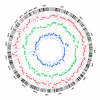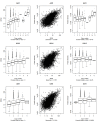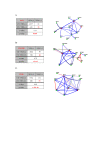Comprehensive analysis of the genome transcriptome and proteome landscapes of three tumor cell lines
- PMID: 23158748
- PMCID: PMC3580420
- DOI: 10.1186/gm387
Comprehensive analysis of the genome transcriptome and proteome landscapes of three tumor cell lines
Abstract
We here present a comparative genome, transcriptome and functional network analysis of three human cancer cell lines (A431, U251MG and U2OS), and investigate their relation to protein expression. Gene copy numbers significantly influenced corresponding transcript levels; their effect on protein levels was less pronounced. We focused on genes with altered mRNA and/or protein levels to identify those active in tumor maintenance. We provide comprehensive information for the three genomes and demonstrate the advantage of integrative analysis for identifying tumor-related genes amidst numerous background mutations by relating genomic variation to expression/protein abundance data and use gene networks to reveal implicated pathways.
Figures





References
-
- Giard DJ, Aaronson SA, Todaro GJ, Arnstein P, Kersey JH, Dosik H, Parks WP. In vitro cultivation of human tumors: establishment of cell lines derived from a series of solid tumors. J Natl Cancer Inst. 1973;51:1417–1423. - PubMed
-
- Westermark B, Ponten J, Hugosson R. Determinants for the establishment of permanent tissue culture lines from human gliomas. Acta Pathol Microbiol Scand A. 1973;81:791–805. - PubMed
LinkOut - more resources
Full Text Sources
Other Literature Sources

